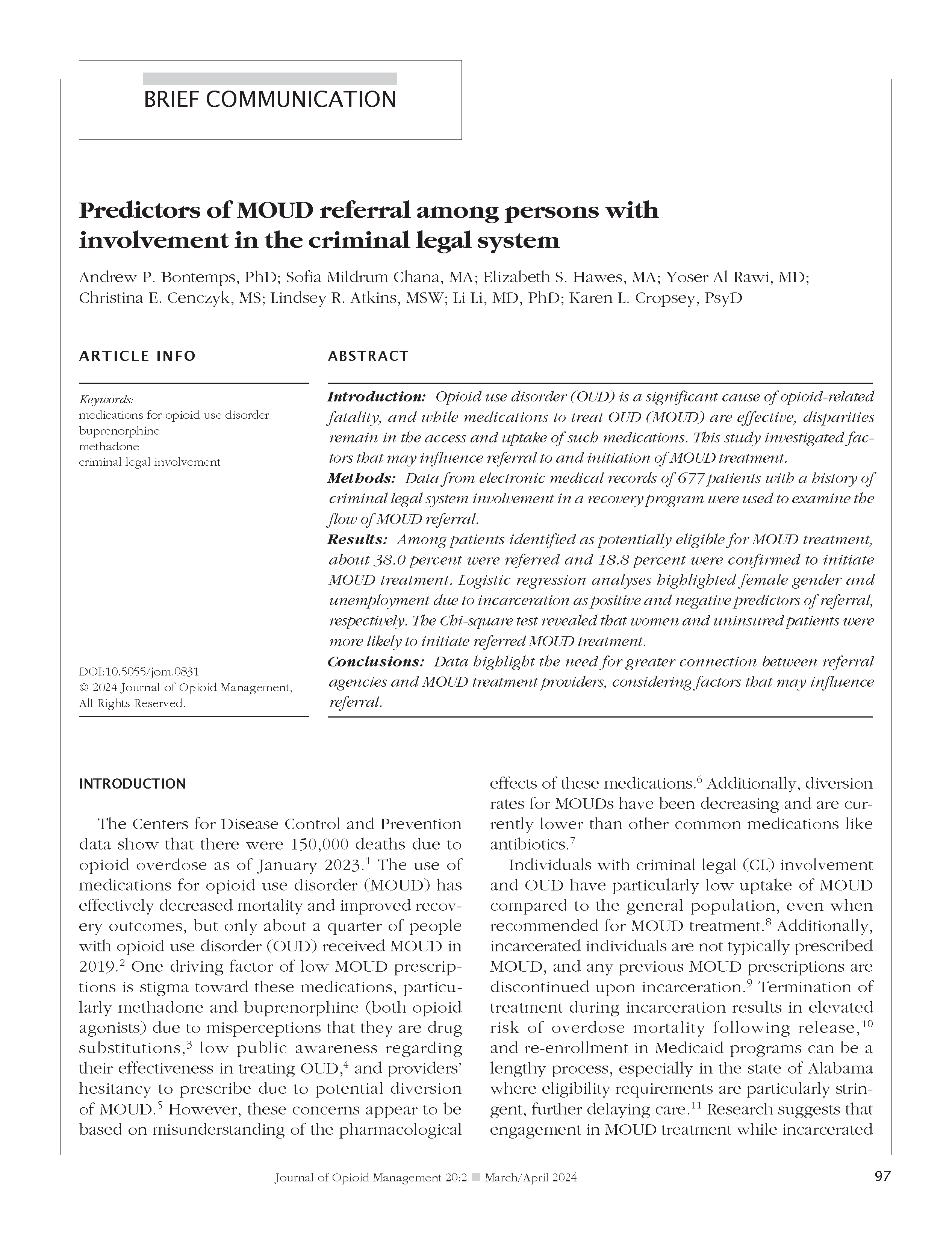Predictors of MOUD referral among persons with involvement in the criminal legal system
DOI:
https://doi.org/10.5055/jom.0831Keywords:
medications for opioid use disorder, buprenorphine, methadone, criminal legal involvementAbstract
Introduction: Opioid use disorder (OUD) is a significant cause of opioid-related fatality, and while medications to treat OUD (MOUD) are effective, disparities remain in the access and uptake of such medications. This study investigated factors that may influence referral to and initiation of MOUD treatment.
Methods: Data from electronic medical records of 677 patients with a history of criminal legal system involvement in a recovery program were used to examine the flow of MOUD referral.
Results: Among patients identified as potentially eligible for MOUD treatment, about 38.0 percent were referred and 18.8 percent were confirmed to initiate MOUD treatment. Logistic regression analyses highlighted female gender and unemployment due to incarceration as positive and negative predictors of referral, respectively. The Chi-square test revealed that women and uninsured patients were more likely to initiate referred MOUD treatment.
Conclusions: Data highlight the need for greater connection between referral agencies and MOUD treatment providers, considering factors that may influence referral.
References
Ahmad F, Cisewski J, Rossen L, et al.: Provisional drug overdose death counts. National Center for Health Statistics. Available at https://www.cdc.gov/nchs/nvss/vsrr/drug-overdosedata.htm. Accessed June 15, 2023.
Mauro PM, Gutkind S, Annunziato EM, et al.: Use of medication for opioid use disorder among US adolescents and adults with need for opioid treatment, 2019. JAMA Netw Open. 2022; 5(3): e223821. DOI: 10.1001/jamanetworkopen.2022.3821. DOI: https://doi.org/10.1001/jamanetworkopen.2022.3821
Volkow ND, Frieden TR, Hyde PS, et al.: Medication-assisted therapies—Tackling the opioid-overdose epidemic. N Engl J Med. 2014; 370(22): 2063-2066. DOI: 10.1056/NEJMp1402780. DOI: https://doi.org/10.1056/NEJMp1402780
Blendon RJ, Benson JM: The public and the opioid-abuse epidemic. N Engl J Med. 2018; 378(5): 407-411. DOI: 10.1056/NEJMp1714529. DOI: https://doi.org/10.1056/NEJMp1714529
Lin LA, Lofwall MR, Walsh SL, et al.: Perceptions and practices addressing diversion among US buprenorphine prescribers. Drug Alcohol Depend. 2018; 186: 147-153. DOI: 10.1016/j.drugalcdep.2018.01.015. DOI: https://doi.org/10.1016/j.drugalcdep.2018.01.015
Lofwall MR, Walsh SL: A review of buprenorphine diversion and misuse: The current evidence base and experiences from around the world. J Addict Med. 2014; 8(5): 315-326. DOI: 10.1097/ADM.0000000000000045. DOI: https://doi.org/10.1097/ADM.0000000000000045
Marlowe DB, Theiss DS, Ostlie EM, et al.: Drug court utilization of medications for opioid use disorder in high opioid mortality communities. J Subst Abuse Treat. 2022; 141: 108850. DOI: 10.1016/j.jsat.2022.108850. DOI: https://doi.org/10.1016/j.jsat.2022.108850
Wogen J, Restrepo MT: Human rights, stigma, and substance use. Health Hum Rights. 2020; 22(1): 51-60.
Green TC, Clarke J, Brinkley-Rubinstein L, et al.: Postincarceration fatal overdoses after implementing medications for addiction treatment in a statewide correctional system. JAMA Psychiatry. 2018; 75(4): 405-407. DOI: 10.1001/jamapsychiatry.2017.4614. DOI: https://doi.org/10.1001/jamapsychiatry.2017.4614
Gordon MS, Kinlock TW, Schwartz RP, et al.: A randomized controlled trial of prison-initiated buprenorphine: Prison outcomes and community treatment entry. Drug Alcohol Depend. 2014; 142: 33-40. DOI: 10.1016/j.drugalcdep.2014.05.011. DOI: https://doi.org/10.1016/j.drugalcdep.2014.05.011
Alabama Medicaid: Available at https://medicaid.alabama.gov/content/3.0_Apply/3.2_Qualifying.aspx. Accessed June 15, 2023.
Kinlock TW, Gordon MS, Schwartz RP, et al.: A randomized clinical trial of methadone maintenance for prisoners: Results at 12 months postrelease. J Subst Abuse Treat. 2009; 37(3): 277-285. DOI: 10.1016/j.jsat.2009.03.002. DOI: https://doi.org/10.1016/j.jsat.2009.03.002
SPSS Statistics for Windows, version 29.0. Chicago, Illinois: SPSS Inc.
Khalid L, Cunningham CO, Deng Y, et al.: Cascade of care for office-based buprenorphine treatment in Bronx community clinics. J Subst Abuse Treat. 2022; 139: 108778. DOI: 10.1016/j.jsat.2022.108778. DOI: https://doi.org/10.1016/j.jsat.2022.108778
Mooney LJ, Valdez J, Cousins SJ, et al.: Patient decision aid for medication treatment for opioid use disorder (PtDA-MOUD): Rationale, methodology, and preliminary results. J Subst Abuse Treat. 2020; 108: 115-122. DOI: 10.1016/j.jsat.2019.08.006. DOI: https://doi.org/10.1016/j.jsat.2019.08.006

Published
How to Cite
Issue
Section
License
Copyright 2005-2025, Weston Medical Publishing, LLC and Journal of Opioid Management. All Rights Reserved.










